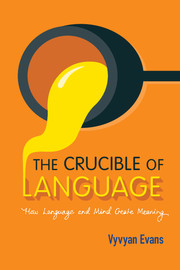Book contents
- Frontmatter
- Dedication
- Epigraph
- Contents
- List of figures
- List of tables
- Preface
- Acknowledgements
- I The ineffability of meaning
- II Meaning in mind
- III Meaning in language
- Chapter 8 Webs of words
- Chapter 9 Meaning in the mix
- Chapter 10 The cooperative species
- Chapter 11 The crucible of language
- Epilogue: The golden triangle
- Notes
- References
- Index
Chapter 9 - Meaning in the mix
from III - Meaning in language
Published online by Cambridge University Press: 05 November 2015
- Frontmatter
- Dedication
- Epigraph
- Contents
- List of figures
- List of tables
- Preface
- Acknowledgements
- I The ineffability of meaning
- II Meaning in mind
- III Meaning in language
- Chapter 8 Webs of words
- Chapter 9 Meaning in the mix
- Chapter 10 The cooperative species
- Chapter 11 The crucible of language
- Epilogue: The golden triangle
- Notes
- References
- Index
Summary
In the novel, As I Lay Dying, William Faulkner narrates the thoughts of his protagonists using a stream-of-consciousness technique. One character, Vardaman, a young child, is in a stall with a horse. Faulkner presents Vardaman's thoughts – using language – to recreate the child's perceptions of his surroundings, and in particular of the horse that Vardaman dimly perceives through the darkness:
It is as though the dark were resolving him out of his integrity, into an unrelated scattering of components—snuffings and stampings; smells of cooling flesh and ammoniac hair; an illusion of a co-ordinated whole of splotched hide and strong bones within which, detached and secret and familiar, an is different from my is. I see him dissolve–legs, a rolling eye, a gaudy splotching like cold flames and float upon the dark in fading solution; all one yet neither; all either yet none. I can see hearing coil toward him, caressing, shaping his hard shape–fetlock, hip, shoulder and head; smell and sound.
The horse emerges to Vardaman through the darkness, not as a single, coherent whole, but in fragments, a ‘scattering of components’. Faulkner brilliantly conveys how the horse seems to the child: Vardaman perceives the disembodied snuffings, the stampings and cooling flesh and the gaudy splotching. But while Faulkner attempts to convey Vardaman's thought processes in the dark stable using language, language is not the same as thought. After all, as I observed in Chapter 6, and in detail in The Language Myth, thought can proceed in the absence of language.
So here's the point: when Faulkner attempts to recreate Vardaman's pure thoughts, using language as the medium for doing so, he is in fact doing more than this. In this chapter, I will show that our human meaning-making capacity is a consequence of the symbiotic interaction between our conceptual system – the repository of our concepts, our units of thought – and language – our linguistic system. Both are essential to produce the complex mental simulations that Faulkner creates in the minds of his readers, as he attempts to recreate Vardaman's thought processes. And in using language to help coordinate and construct Vardaman's thoughts, Faulkner is not in fact presenting pure, distilled thought. Language is not the same as thought.
- Type
- Chapter
- Information
- The Crucible of LanguageHow Language and Mind Create Meaning, pp. 225 - 251Publisher: Cambridge University PressPrint publication year: 2015



